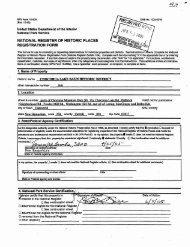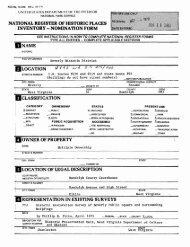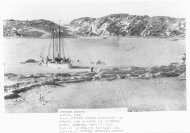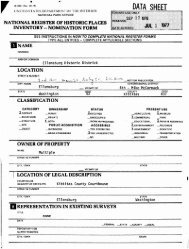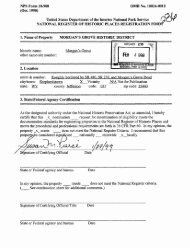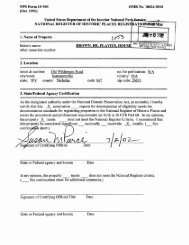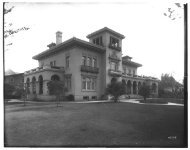National Register of Historic Places Registration Form
National Register of Historic Places Registration Form
National Register of Historic Places Registration Form
Create successful ePaper yourself
Turn your PDF publications into a flip-book with our unique Google optimized e-Paper software.
NFS <strong>Form</strong> 10-900-a OMB Approval No. 1024-0018<br />
(8-86)<br />
United States Department <strong>of</strong> the Interior<br />
<strong>National</strong> Park Service<br />
<strong>National</strong> <strong>Register</strong> <strong>of</strong> <strong>Historic</strong> <strong>Places</strong><br />
Continuation Sheet<br />
CLEVELAND PARK HISTORIC DISTRICT<br />
WASHINGTON D.C.<br />
Section number 8 Rage J*__<br />
precedent followed by other wealthy Washingtonians and chose a house in this<br />
area to be his summer home and consequently the "Summer White House." The<br />
streetcar suburb <strong>of</strong> the 1890's followed by the rise <strong>of</strong> apartment buildings and<br />
the shopping area along Connecticut Avenue making this a self sufficient<br />
neighborhood dramatically exemplifies the urban exodus at the turn <strong>of</strong> the<br />
century. The explosion <strong>of</strong> population into the outlying areas beyond the city<br />
center was facilitated and made possible by the construction <strong>of</strong> bridges across<br />
Rock Creek and the quick and convenient transportation provided initially by<br />
the electric streetcar and subsequently by the automobile which rapidly became<br />
a standard family possession. These periods <strong>of</strong> the history <strong>of</strong> Washington D.C.<br />
are visually represented in Cleveland Park because <strong>of</strong> the original land forms<br />
with hills, curving roads,and landscaping as well as the architectural<br />
structures themselves and their relationships all <strong>of</strong> which have been<br />
maintained throughout the passage <strong>of</strong> time. All <strong>of</strong> this has ensured that the<br />
integrity <strong>of</strong> location, design, materials, workmanship, setting, feeling and<br />
association has been maintained and exists at the present time visually<br />
recalling the past periods and the overlay <strong>of</strong> history from 1795 to the present<br />
in a single integrated neighborhood. (Criteria C; Areas <strong>of</strong> Significance:<br />
Community Planning and Development and Architecture)<br />
The Cleveland Park <strong>Historic</strong> District definitely conveys a sense <strong>of</strong><br />
architectural cohesiveness through its design, setting, materials, workmanship<br />
and association. The architectural styles which cover a range <strong>of</strong> time periods<br />
but represent a continuous line <strong>of</strong> development give a sense <strong>of</strong> the passage <strong>of</strong><br />
time. As you walk through Cleveland Park you can recall the era <strong>of</strong> the<br />
country estates as you pass the open space <strong>of</strong> Rosedale, Twin Oaks and<br />
Tregaron; juxtaposed to this is the suburban development so evident from<br />
Woodley Road to Rodman with a predominance <strong>of</strong> frame houses set amidst generous<br />
front and side lawns many <strong>of</strong> which are located on hills and curving streets.<br />
Enter Wisconsin or Connecticut Avenue and you are reminded that this rural<br />
neighborhood is only 15 minutes from downtown Washington D.C. Along<br />
Connecticut Avenue the flavor <strong>of</strong> the linear commercial development <strong>of</strong> the<br />
1920s with numerous individual shops each with a different storefront is<br />
adjacent to the prototype shopping center set back from the avenue with a<br />
large parking lot in front to service the automobile populus which was<br />
clogging the city with traffic and demanding attention to its needs at the end<br />
<strong>of</strong> the 1920's. The contrast <strong>of</strong> these two distinct elements (residential and<br />
commercial) and their interrelatedness and mutual interdependence are<br />
distinctive features <strong>of</strong> the Cleveland Park <strong>Historic</strong> District and represent so<br />
clearly the growth and change <strong>of</strong> the Washington D.C. metropolitan area as the<br />
urban dwellers sought a more rural lifestyle when improved transportation made<br />
that a realistic possibility. (Criteria C; Areas <strong>of</strong> Significance: Community<br />
Planning and Development and Architecture)



